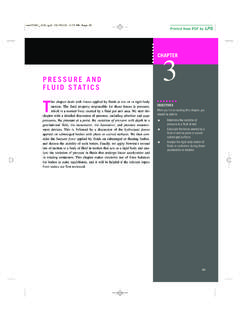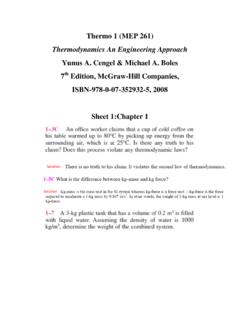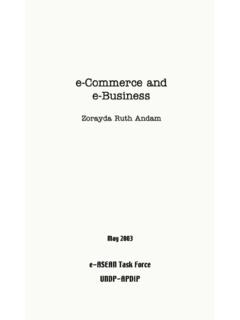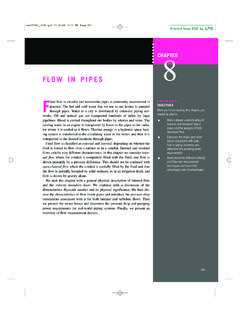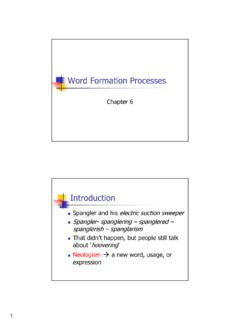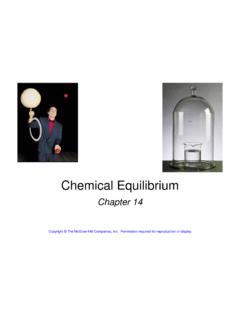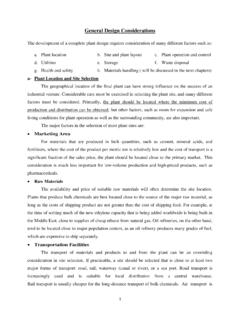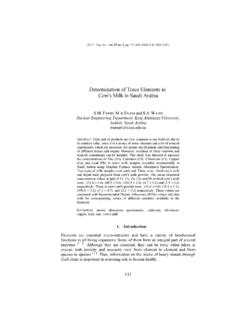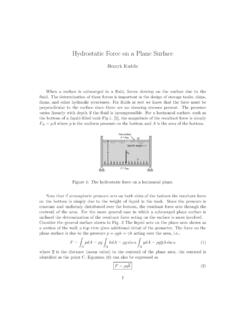Transcription of PRESSURE AND FLUID STATICS T - kau
1 PRESSURE AND FLUID STATICSThis chapter deals with forces applied by fluids at rest or in rigid-bodymotion. The FLUID property responsible for those forces is PRESSURE ,which is a normal force exerted by a FLUID per unit area. We start thischapter with a detailed discussion of PRESSURE , including absoluteand gagepressures, the PRESSURE at a point, the variation of PRESSURE with depthin agravitational field, the manometer, the barometer, and PRESSURE measure-ment devices. This is followed by a discussion of the hydrostatic forcesapplied on submerged bodies with plane or curved surfaces .
2 We then con-sider the buoyant forceapplied by fluids on submerged or floating bodies,and discuss the stabilityof such bodies. Finally, we apply Newton s secondlaw of motion to a body of FLUID in motion that acts as a rigid body and ana-lyze the variation of PRESSURE in fluids that undergo linear acceleration andin rotating containers. This chapter makes extensive use of force balancesfor bodies in static equilibrium, and it will be helpful if the relevant topicsfrom STATICS are first you finish reading this chapter, youshould be able to Determine the variation ofpressure in a FLUID at rest Calculate the forces exerted by afluid at rest on plane or curvedsubmerged surfaces Analyze the rigid-body motion offluids in containers during linearacceleration or 10/29/04 2:21 PM Page 653 1 PRESSUREP ressureis defined as a normal force exerted by a FLUID per unit area.
3 Wespeak of PRESSURE only when we deal with a gas or a liquid. The counterpartof PRESSURE in solids is normal stress. Since PRESSURE is defined as force perunit area, it has the unit of newtons per square meter (N/m2), which is calleda pascal(Pa). That is,The PRESSURE unit pascal is too small for pressures encountered in prac-tice. Therefore, its multiples kilopascal(1 kPa 103Pa) and megapascal(1 MPa 106Pa) are commonly used. Three other PRESSURE units com-monly used in practice, especially in Europe, are bar, standard atmosphere,and kilogram- force per square centimeter:Note the PRESSURE units bar, atm, and kgf/cm2are almost equivalent to eachother.
4 In the English system, the PRESSURE unit is pound- force per squareinch(lbf/in2, or psi), and 1 atm psi. The PRESSURE units kgf/cm2and lbf/in2are also denoted by kg/cm2and lb/in2, respectively, and they arecommonly used in tire gages. It can be shown that 1 kgf/cm2 is also used for solids as synonymous to normal stress,which isforce acting perpendicular to the surface per unit area. For example, a 150-pound person with a total foot imprint area of 50 in2exerts a PRESSURE of150 lbf/50 in2 psi on the floor (Fig. 3 1). If the person stands on onefoot, the PRESSURE doubles.
5 If the person gains excessive weight, he or she islikely to encounter foot discomfort because of the increased PRESSURE on thefoot (the size of the foot does not change with weight gain). This alsoexplains how a person can walk on fresh snow without sinking by wearinglarge snowshoes, and how a person cuts with little effort when using a actual PRESSURE at a given position is called the absolute PRESSURE ,and it is measured relative to absolute vacuum ( , absolute zero PRESSURE ).Most PRESSURE -measuring devices, however, are calibrated to read zero in theatmosphere (Fig. 3 2), and so they indicate the difference between theabsolute PRESSURE and the local atmospheric PRESSURE .
6 This difference iscalled the gage below atmospheric PRESSURE are calledvacuum pressuresand are measured by vacuum gages that indicate the dif-ference between the atmospheric PRESSURE and the absolute , gage, and vacuum pressures are all positive quantities and arerelated to each other by(3 1)(3 2)This is illustrated in Fig. 3 Patm PabsPgage Pabs Patm atm bar 1 kgf cm2 N cm2 104 N m2 104 Pa 1 atm 101,325 Pa kPa bars 1 bar 105 Pa MPa 100 kPa 1 Pa 1 N m266 FLUID MECHANICS150 poundsAfeet = 50 in2P = 3 psiP = 6 psi300 poundsW Afeet150 lbf 50 in2P = n == 3 psi=sFIGURE 3 1 The normal stress (or PRESSURE ) on the feet of a chubby person is much greater than on the feet of a slim 3 2 Two basic PRESSURE Instruments, Dresser, Inc.
7 Used 10/29/04 2:21 PM Page 6667 CHAPTER 3 AbsolutevacuumAbsolutevacuumPabsPvacPatm PatmPatmPgagePabsPabs = 0 FIGURE 3 3 Absolute, gage, and vacuum other PRESSURE gages, the gage used to measure the air PRESSURE in anautomobile tire reads the gage PRESSURE . Therefore, the common reading of32 psi ( kgf/cm2) indicates a PRESSURE of 32 psi above the atmosphericpressure. At a location where the atmospheric PRESSURE is psi, for exam-ple, the absolute PRESSURE in the tire is 32 thermodynamic relations and tables, absolute PRESSURE is almost alwaysused. Throughout this text, the PRESSURE Pwill denote absolute pressureunless specified otherwise.
8 Often the letters a (for absolute PRESSURE ) and g (for gage PRESSURE ) are added to PRESSURE units (such as psia and psig) toclarify what is 3 1 Absolute PRESSURE of a Vacuum ChamberA vacuum gage connected to a chamber reads psi at a location wherethe atmospheric PRESSURE is psi. Determine the absolute PRESSURE in gage PRESSURE of a vacuum chamber is given. The absolutepressure in the chamber is to be absolute PRESSURE is easily determined from Eq. 3 2 to beDiscussionNote that the localvalue of the atmospheric PRESSURE is usedwhen determining the absolute at a PointPressure is the compressive forceper unit area, and it gives the impressionof being a vector.
9 However, PRESSURE at any point in a FLUID is the same in alldirections. That is, it has magnitude but not a specific direction, and thus itis a scalar quantity. This can be demonstrated by considering a smallwedge-shaped FLUID element of unit length (into the page) in equilibrium, asshown in Fig. 3 4. The mean pressures at the three surfaces are P1,P2, andP3, and the force acting on a surface is the product of mean PRESSURE and thePabs Patm Pvac 10/29/04 2:21 PM Page 67surface area. From Newton s second law, a force balance in the x- and z-directions gives(3 3a)(3 3b)where ris the density and W mg rg x z/2 is the weight of the fluidelement.
10 Noting that the wedge is a right triangle, we have x lcos uand z lsin u. Substituting these geometric relations and dividing Eq. 3 3aby zand Eq. 3 3b by xgives(3 4a)(3 4b)The last term in Eq. 3 4b drops out as z 0 and the wedge becomesinfinitesimal, and thus the FLUID element shrinks to a point. Then combiningthe results of these two relations gives(3 5)regardless of the angle u. We can repeat the analysis for an element in thexz-plane and obtain a similar result. Thus we conclude that the PRESSURE at apoint in a FLUID has the same magnitude in all directions. It can be shown inthe absence of shear forces that this result is applicable to fluids in motionas well as fluids at of PRESSURE with DepthIt will come as no surprise to you that PRESSURE in a FLUID at rest does notchange in the horizontal direction.
